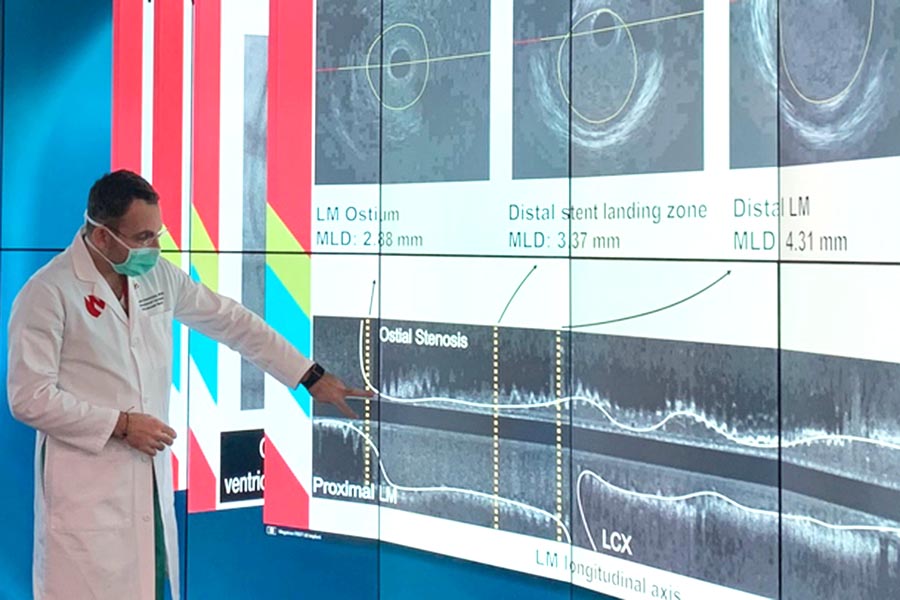NVIDIA DGX Supercomputer

Using the power of the DGX A100 super computer, Yiannis Chatzizisis, MD, PhD, examines patient-specific computer simulations of coronary artery stenting procedures. "The system can handle a large amount of data and run multiple tasks simultaneously," he said.
Rapidly and efficiently process big data – from the genome to population-based research – with our secure, HIPAA-compliant supercomputer.
Researchers can use the NVIDIA DGX A100 supercomputer to analyze thousands of data points, charts and clinical encounters, and other data sources to create predictive models of disease.
The supercomputer is helping create a new era of precision health care by delivering to clinicians the right information at the right time and in the right format. Center director John Windle, MD, said, "Linking human cognition and artificial intelligence with good data, and the right algorithms and analytics, will help us achieve that precision."
“The DGX supercomputer is great. Its capabilities far exceed anything that we have had access to before, and it’s specifically designed to train deep learning models.”

David Ellis
Data Analyst, UNMC Department of Neurosurgery
Artificial Intelligence Infrastructure Support
Our center offers resource for supporting the projects of researchers, clinicians, computer scientists and data scientists.
- Study design
- Business case development
- IRB support
- Identify collaborators
- NVIDIA DGX Supercomputer
- Identify software requirements
- Administrative hardware
- Data management
- Identify data sources
- ETL: Extract, Transform, Load
- Information security
- Stay within enterprise firewall with sensitive data
How to Use the Supercomputer
To use the supercomputer, an individual must have (or be assigned) a UNMC or Nebraska Medicine email and submit a request for access through Redcap. The CIHC team then reviews the request, ensures that the requester receives HIPAA and ethics training and then grants access to use the supercomputer.
Our center team also can help align researchers — whether from the other NU campuses or private entities — with the necessary IT expertise to create successful projects. Fees are $0.025/CPU/hr and $4.99/GPU/hr.
DGX A100 Projects
The PainChat app is a conversational agent powered by generative artificial intelligence. It will be part of a digital solution offered for geriatric pain management and will be used to conduct guided conversations with older adults experiencing chronic pain to evaluate their pain in real time and in their natural environment.
PainChat app will be powered by a lNatural Language Processing Engine consisting of a language model that utilizes computing power of the DGX A100 for training and fine-tuning stages on training data. The DGX A100 will also be used at the inference time by the NLP Engine to generate empathetic responses to patient inputs.
Hypertension is a major risk factor for serious health problems such as kidney failure, stroke, and heart disease. Despite established clinical practice guidelines and effective treatment options, there is still a gap in accurately diagnosing hypertension.
Electronic health records provide a wealth of health data that can be analyzed using artificial intelligence, which is a promising method for improving clinical medicine.
This team is using the DGX supercomputer to enhance understanding of hypertension using AI, explore causal inference, and examine clinical experts' decision-making processes.
We are working on detecting serious foot fractures from x-ray scans. These foot fractures, called Lisfranc injuries, involve the damage to the midfoot and are misdiagnosed at a rate of 20% to 50%.
By using AI, we aim to provide technology to detect these fractures more accurately in x-ray scans. This technology could empower providers to efficiently and cost effectively improve patient care and limit long-term effects of missed Lisfranc injuries.
Led by Thomas Porter, M.D., researchers at the center are using machine learning techniques to better identify myocardial blockages using Real Time Perfusion Echocardiography. This technique, developed at UNMC, uses microbubbles diluted in saline to reveal the border and thickness of the heart walls, as well as tiny vessels that provide blood to the heart.
Machine learning techniques can improve the precision of these perfusion images as well as provide better accuracy of the location of potential blockages.
The DGX computer will be used to test and improve open-source large language models, such as Large Language Model Meta AI. After development of the large language model, the DGX computer will communicate with the robotic health attendant as the robot’s intelligence to perform situational understanding and performance of high-level task planning.
The outcome of this project will help mitigate physical and informational burdens on health care staff, eventually improving patient care and worker well-being.
Artificial Intelligence Support Team
James Tcheng, chief data scientist
Tom Windle, clinical informaticist
Melissa Christian, manager
Ashok Mudgapalli, director of research IT office
Creating an Ecosystem
The supercomputer is part of our center's ecosystem of big-data, computers, software and expertise, allowing us to provide the research services that are needed.
Our team also can help align researchers — whether from the other NU campuses or private entities — with the necessary IT expertise to create successful projects.
Acquisition, implementation and administration of the supercomputer was made possible by UNMC's Research Information Technology Office.